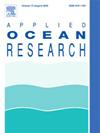Effects of wave spectrum representation on power production estimations from point absorbers
IF 4.4
2区 工程技术
Q1 ENGINEERING, OCEAN
引用次数: 0
Abstract
This study presents a first long term (30 years) assessment to quantify the effects of both, the wave spectrum representation, and occurrences of multi-modal sea states, on power production estimations from a point-absorber Wave Energy Converter (WEC). Analysis in 3 different offshore locations (Portugal, Ireland and The Netherlands) is included to ensure robustness of results. In general, traditional methods based on the use of the JONSWAP spectrum, with an adequate gamma shape value, can lead to mean overestimation in yearly power production when compared to reference hindcast spectral data. This can be partially reduced when capping is applied to power production, but still can be close to . An alternative method is proposed to modulate the JONSWAP spectrum at each time step which helps to reduce differences, but leads to slight yearly underestimations (−2.5 to −5% in average). Although in all analyzed sites the occurrences of multi-modal spectra is , contribution to errors due to misrepresentation of these sea states are estimated to be of about . These findings provide valuable insights on the uncertainties introduced in power production estimations, related to wave conditions characterization, that can have important economic impact when planning for large scale deployments.
波谱表示对点吸收器发电量估计的影响
本研究提出了第一个长期(30年)评估,以量化波浪谱表示和多模态海况的发生对点吸收波能转换器(WEC)发电估计的影响。分析包括在3个不同的离岸地点(葡萄牙,爱尔兰和荷兰),以确保结果的稳健性。通常,基于使用JONSWAP光谱的传统方法,具有适当的gamma形状值,与参考后验光谱数据相比,可能导致年发电量的平均高估>;12%。当封顶应用于电力生产时,这可以部分减少,但仍然可以接近10%。提出了在每个时间步长调制JONSWAP光谱的替代方法,这有助于减少差异,但会导致轻微的年低估(平均为- 2.5至- 5%)。虽然在所有分析的地点中,多模态光谱的出现率为30%,但由于这些海况的错误表示造成的误差估计约为2.5%。这些发现为电力生产估算中引入的不确定性提供了有价值的见解,这些不确定性与波浪条件表征有关,在规划大规模部署时可能会产生重要的经济影响。
本文章由计算机程序翻译,如有差异,请以英文原文为准。
求助全文
约1分钟内获得全文
求助全文
来源期刊

Applied Ocean Research
地学-工程:大洋
CiteScore
8.70
自引率
7.00%
发文量
316
审稿时长
59 days
期刊介绍:
The aim of Applied Ocean Research is to encourage the submission of papers that advance the state of knowledge in a range of topics relevant to ocean engineering.
 求助内容:
求助内容: 应助结果提醒方式:
应助结果提醒方式:


